This post may contain affiliate links. Please read my privacy policy.
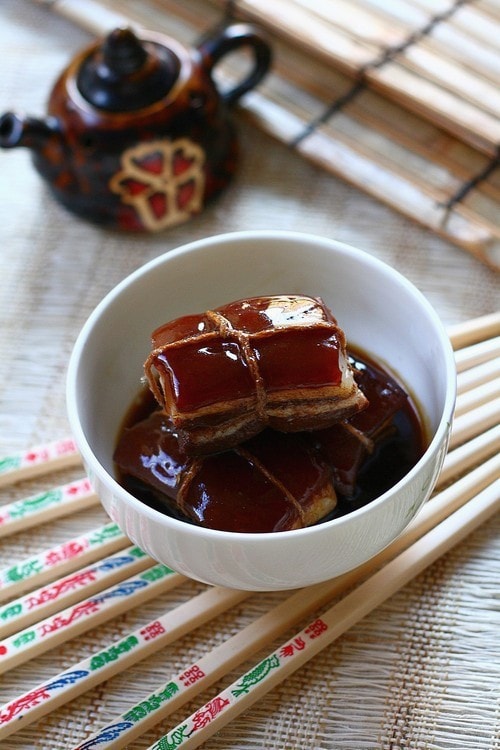
Pork is most definitely not just “the other white meat” in China.
From the smoky and delicious Chinese BBQ Pork (叉烧) and crispy Chinese roast pork (烧肉) in Cantonese cuisine to the dainty Xiao Long Bao (小笼包) from Shanghai and numerous other famous Chinese pork dishes in between, pork is clearly the meat of choice in Chinese recipes.
In fact, the Chinese character for meat “肉” (ròu), refers to pork if no particular meat is specified (e.g. 咕噜’肉’ translates to Sweet and Sour ‘Pork’).
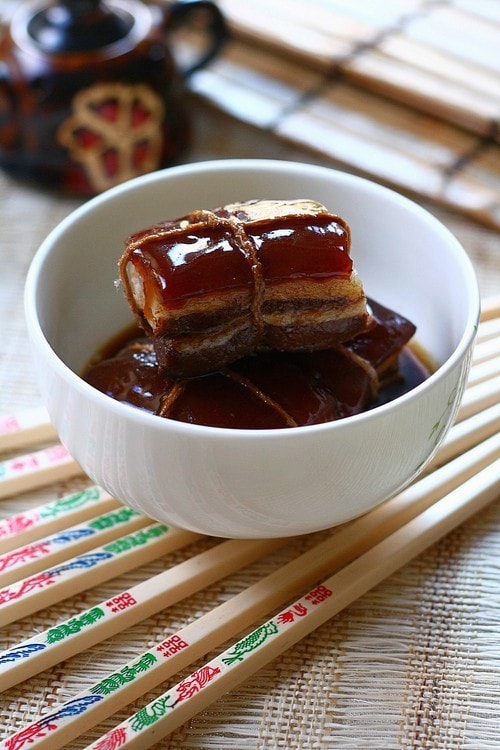
History and Origin of Dong Po Rou
During one of my travels to China, I had the pleasure of introducing my taste buds to a deservedly popular pork dish in Chinese cuisine—the delicate and delectable Braised Pork Belly, Dongpo Pork (东坡肉). As I have mentioned before, many Chinese dish names tell interesting stories, like Beggar’s Chicken (叫化鸡) or Goubuli Baozi (狗不理包子).
Dongpo Pork is an iconic feature of Hangzhou (杭州) cuisine and can be attributed to Su Shi (苏轼) a.k.a Su Dongpo (苏东坡), a scholar and court official during the Song Dynasty (宋朝), renowned today for his brilliance in poetry, calligraphy, and writings in Chinese literary history.
There was a time when Su Dongpo was demoted for criticizing the emperor and sent to Huangzhou (黄州) in exile.
One day, he was so engrossed in a game of Chinese chess (象棋) with an old friend that he forgot all about the Red-Cooked Pork Belly (红烧肉) braising on his stove.
The fragrant aroma from the lengthy braising drifting in from the kitchen suddenly reminded him.
As he took a bite of the pork, he was pleasantly surprised to find that the dish he thought had been ruined turned out to be even more tender and tastier than expected.
Dongpo Pork was thus born.
When he was later stationed in Hangzhou (杭州) and was overseeing a reconstruction project on the West Lake (西湖), he cooked the same dish with the pork cut up into cubes and distributed them to the workers as a sign of gratitude.
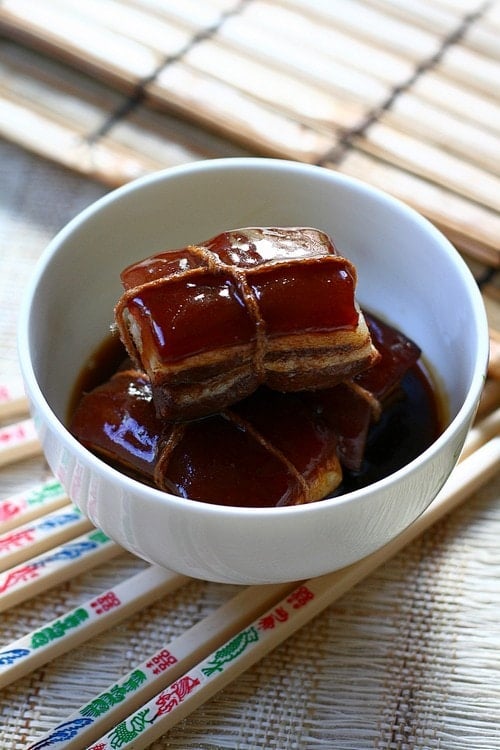
The dish was thoroughly enjoyed by all and Dongpo Pork rapidly gained popularity then and there right up to the present day, where it has become a notable signature dish in Hangzhou cuisine and famous all around the world.
Difference of Dong Po Rou and Red-Cooked Pork
The key discerning factor between Red-Cooked Pork and Dong Po Pork is undoubtedly the lengthier braising process, which increases the caramelization of the sugar to enhance the flavor, infuses the cooking wine into the meat longer for an even richer fragrance, and last but definitely not least, breaks down the fat further to give the pork that tender “melt-in-your-mouth” texture minus the greasiness.
In other words, this is one dish that is definitely worth the wait.
And as a bonus for your patience, you can casually forget about setting your kitchen timer and wait for the tantalizing aromas to remind you of the mouthwatering concoction simmering on your stovetop.
How Many Calories per Serving
This recipe is only 376 calories per serving.
What Dishes to Serve with This Recipe?
In China, a meat dish often goes with a bowl of pipping hot steamed white rice, which is the traditional way of eating. However, you can serve with a variation of carb, for examples: fried rice or shrimp fried rice.
However, my personal favorite is serving it with steamed buns (mantou) or scallion buns as I can sop up the scrumptious sauce with the fluffy buns. If you don’t like steamed buns, you can certainly serve with scallion pancakes.
For a wholesome Chinese meal, I also suggest pairing the pork with a plate of stir-fried vegetables such as: bok choy chicken or garlic bok choy. If you want to have a fancier dinner, especially if you are hosting your friends, I suggest a spread of iconic Chinese dishes below. Enjoy!
For more great recipes like this, sign up for our newsletter. We’ll send daily recipes you’ll love!
Sign up for our newsletter!
Braised Pork Belly (Dong Po Rou/东坡肉)
Ingredients
Equipment:
- clay pot (dutch oven or stainless steel pot)
- Food safety strings (optional)
Ingredients:
- 1 lb (500g) pork belly
- 1 tablespoon oil
- 3 stalks scallions (cut into 3-inch (6 cm) lengths)
- 1- inch (2.5cm) peeled ginger (cut into slices)
- 2-3 tablespoons low sodium soy sauce or 1-2 tablespoons regular soy sauce
- 2 tablespoons dark soy sauce
- 3 1/2 tablespoons Shaoxing wine
- water (enough to cover the pork belly)
- 1 oz (30g) rock sugar, lightly crushed or 2 1/2 tablespoons (40 g) brown sugar
- extra sugar (as per taste)
Instructions
- Bring a pot of water to boil. Add the pork belly and boil for 5 minutes. Discard water, remove pork from pot, rinse and pat dry. Cut the meat into 2 1/2-inch (6cm) squares. Tie the pork pieces with food safety strings as tight as possible to avoid meat from falling apart while braising.
- Heat up a clay pot or stainless steel pot with oil, stir-fry the ginger and scallions until aromatic. Pour in the water and continue boiling for 10 minutes.
- Add light soy sauce, dark soy sauce and wine, adequate amount of water just to cover the pork belly and boil in high heat. Mix in rock sugar, pork pieces, skin side down and cook for 5 minutes.
- Lower the heat to medium-low, at a gentle simmering level, cover the pot and braise pork for 30 minutes. Turn pork skin side 'up', and continue braising for 1 1/2-2 hours, or until pork is tender enough to your liking. Adjust seasoning, as per taste, eg. sugar.
- Dish up and serve pork with Dongpo sauce over steamed rice or buns and vegetables.
Notes
Food safety string is not required if you prefer to braise the whole slab of pork belly.
Hence, skip the cutting part of the pork belly.
You can use regular Shaoxing Wine for the Dongpo Pork recipe. Shaoxing 'Hua Tiao' wine will add a more robust and richer flavor to the dish.
Nutrition
Notice: Nutrition is auto-calculated, using Spoonacular, for your convenience. Where relevant, we recommend using your own nutrition calculations.
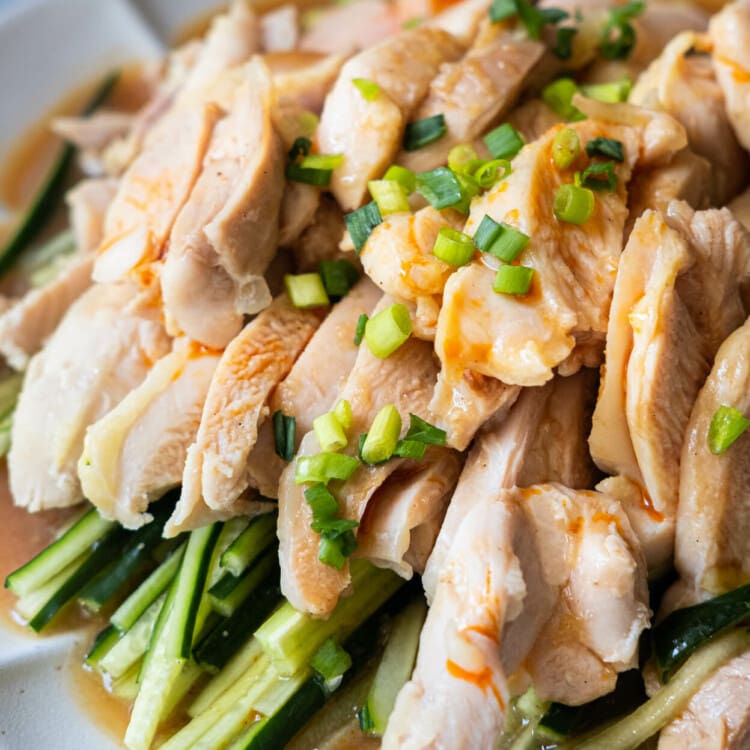
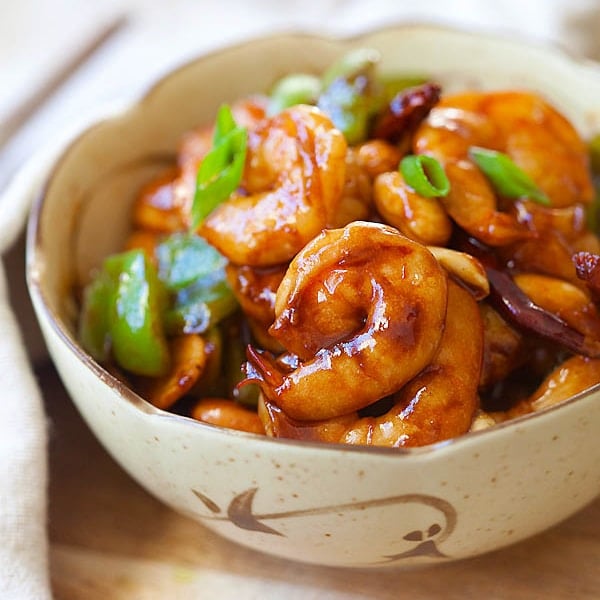
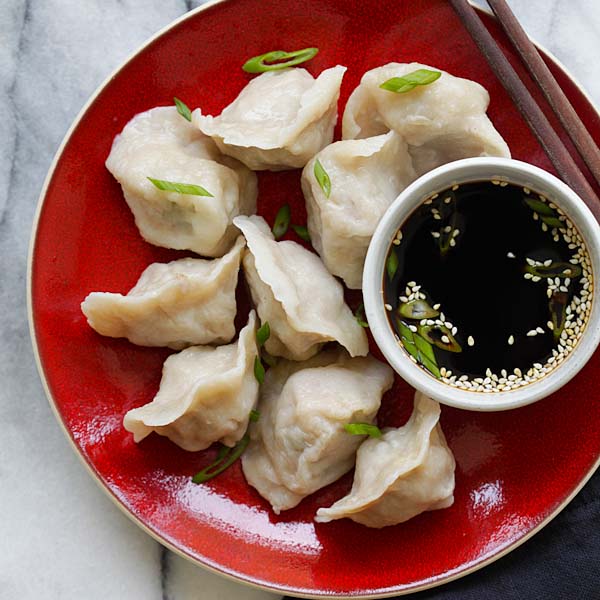
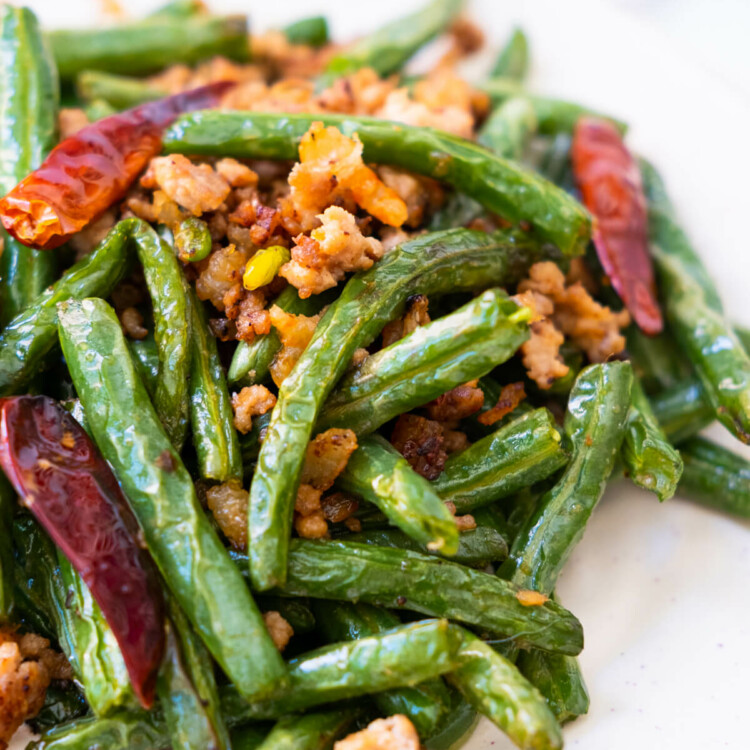
does the time at the bottom mean 11 hours or 1 to 2hours? thanks
does the time at the bottom mean 11 hours or 1 to 2hours? thanks
I think it’s 1 hour and 30min/2 hours
I came across this reference to Dong Po Rou in Chinese Gastronomy, by Hsiang Ju Lin and Tsuifeng Lin, published in 1969: “The square of fat [Tungpo pork] is regarded with much passion, tenderness, and expectation . . .People sigh, shout, and groan with happiness when they see it. This is one of the pinnacles of gastronomy, and sums
up the appreciation of fat in Chinese cuisine.” Seeking a recipe, I found your site, and just seeing a photo of the dish made me “sigh, shout, and groan with happiness.” I can’t wait to taste it! Meanwhile, I’ve ordered your book from Amazon. It’s an amazing world … at least sometimes.
this is my FAVOURITE rasa malaysia recipe hands down.
I tried it out, LOVED it. Just be watchful not to burn the pork /let it stick to the pot bottom towards the end of cooking! Best Dongpo Meat I’ve ever eaten, and I’m Chinese living in China. Lots of love!
Wow, thanks so much for trying out this recipe. :)
can cook this in a electric pressure cooker and how?
Hi, I just tred your recipe but I added sugar to the oil before stir browning the belly pieces. Does this make the pork belly ooze out a lot of fat?
By the end of braising all if the water seemed to have evaporated and it found my pork bellies braising in its out fat! Needless to the the pork still came out delicious but I didn’t get that thick caramelly gravy at the end.
I think there is a step missing from ur recipe . Do we add the pork to the pan after we stir fry the scallions and ginger? Do we brown it or immediately pour water in it?
Thanks!